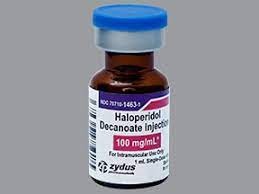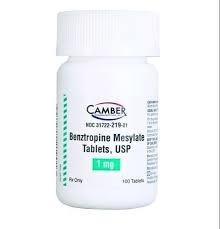A nurse is preparing to administer haloperidol 75 mg IM per week. Available is haloperidol decanoate 100mg/ml for injection. How many ml should the nurse administer per dose? (Round the answer to the nearest hundredth. Use a leading zero if it applies.
The Correct Answer is ["0.75"]
To calculate the volume (ml) of haloperidol decanoate needed for a dose of 75 mg, you can use the following formula:
Volume (ml) = Dose (mg) / Concentration (mg/ml)
Given:
Dose = 75 mg
Concentration = 100 mg/ml
Plugging in the values:
Volume (ml) = 75 mg / 100 mg/ml
Volume (ml) = 0.75 ml
Rounding to the nearest hundredth:
Volume (ml) = 0.75 ml
So, the nurse should administer 0.75 ml of haloperidol decanoate for the dose of 75 mg.

Nursing Test Bank
Naxlex Comprehensive Predictor Exams
Related Questions
Correct Answer is ["2"]
Explanation
The nurse is preparing to administer benztropine 2 mg IM every 12 hours. The concentration of the available benztropine is 1 mg/mL.
To calculate the volume (mL) of the medication needed for the prescribed dose, you can use the formula:
Volume (mL) = Dose (mg) / Concentration (mg/mL)
Plugging in the values:
Volume (mL) = 2 mg / 1 mg/mL = 2 mL
So, the nurse should administer 2 mL of benztropine 1 mg/mL for each dose. Since we're looking for a whole number, we round to the nearest whole number, which is 2 mL.

Correct Answer is C
Explanation
A. Brief Patient Health Questionnaire (Brief PHQ):
The Brief PHQ is a screening tool used to assess symptoms of depression. While it may be relevant to assess mood and emotional well-being, it is not specific to evaluating cognitive functioning or cognitive disorders.
B. Abnormal Involuntary Movements Scale (AIMS):
The AIMS is used to assess involuntary movements, particularly in individuals taking antipsychotic medications. It is not directly related to assessing cognitive disorders.
C,. Mental status examination (MSE)
Explanation:
When admitting an older adult client with a suspected cognitive disorder, including a mental status examination (MSE) as part of the assessment is crucial. The MSE is a structured assessment of a client's current cognitive functioning, emotional state, and thought processes. It helps to evaluate memory, attention, language, perception, orientation, mood, and other cognitive and emotional domains.
D. Scale for Assessment of Negative Symptoms (SANS):
The SANS is used to assess negative symptoms in individuals with schizophrenia. It focuses on features such as affective blunting, alogia, anhedonia, and other negative symptoms. While it may provide important information about a client's mental state, it is not primarily used to assess cognitive disorders.
Assessing cognitive function is a key component when evaluating older adult clients for cognitive disorders such as dementia or other cognitive impairments. The MSE provides valuable information to guide diagnosis and treatment planning for these conditions.
Whether you are a student looking to ace your exams or a practicing nurse seeking to enhance your expertise , our nursing education contents will empower you with the confidence and competence to make a difference in the lives of patients and become a respected leader in the healthcare field.
Visit Naxlex, invest in your future and unlock endless possibilities with our unparalleled nursing education contents today
Report Wrong Answer on the Current Question
Do you disagree with the answer? If yes, what is your expected answer? Explain.
Kindly be descriptive with the issue you are facing.
